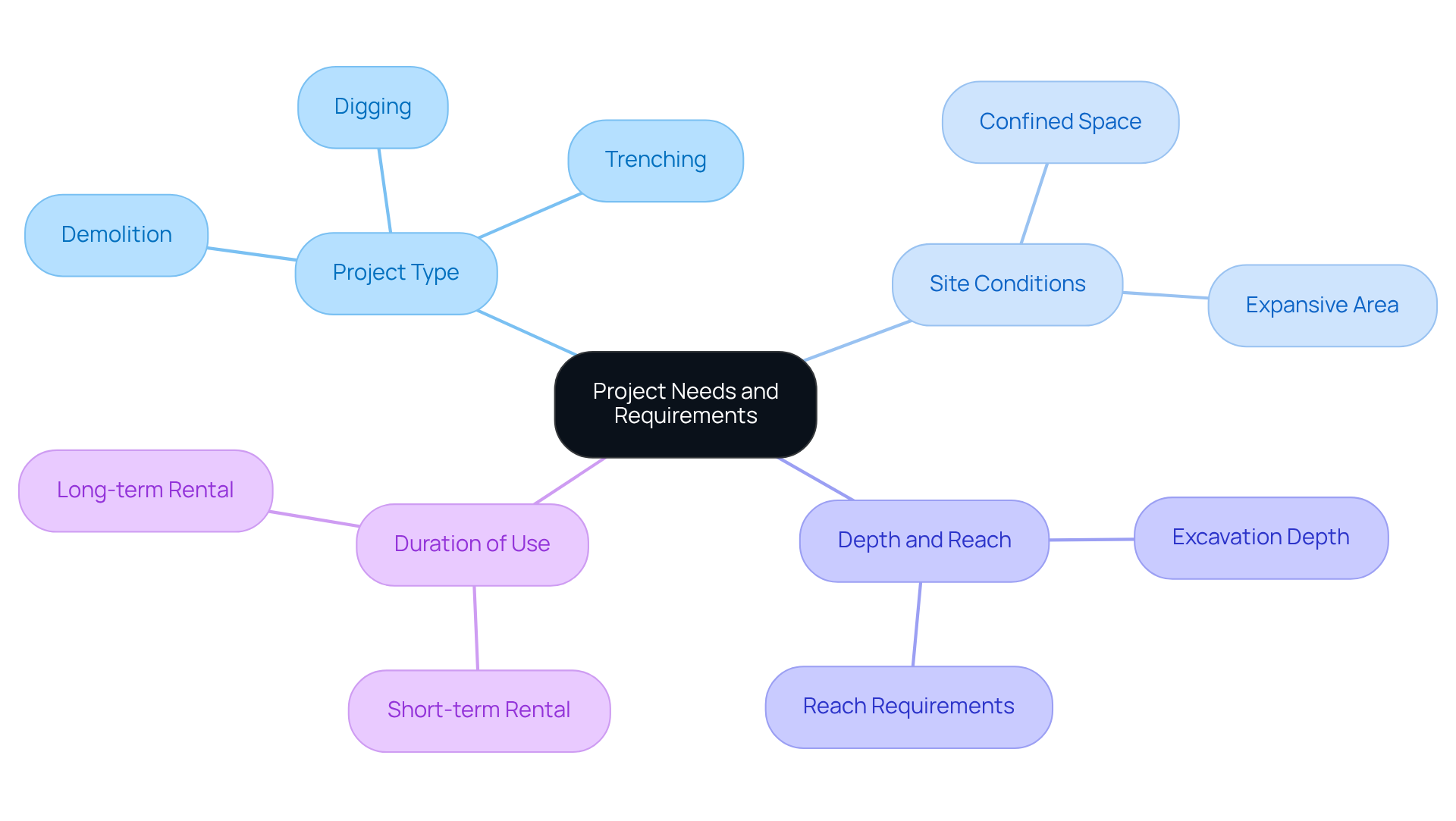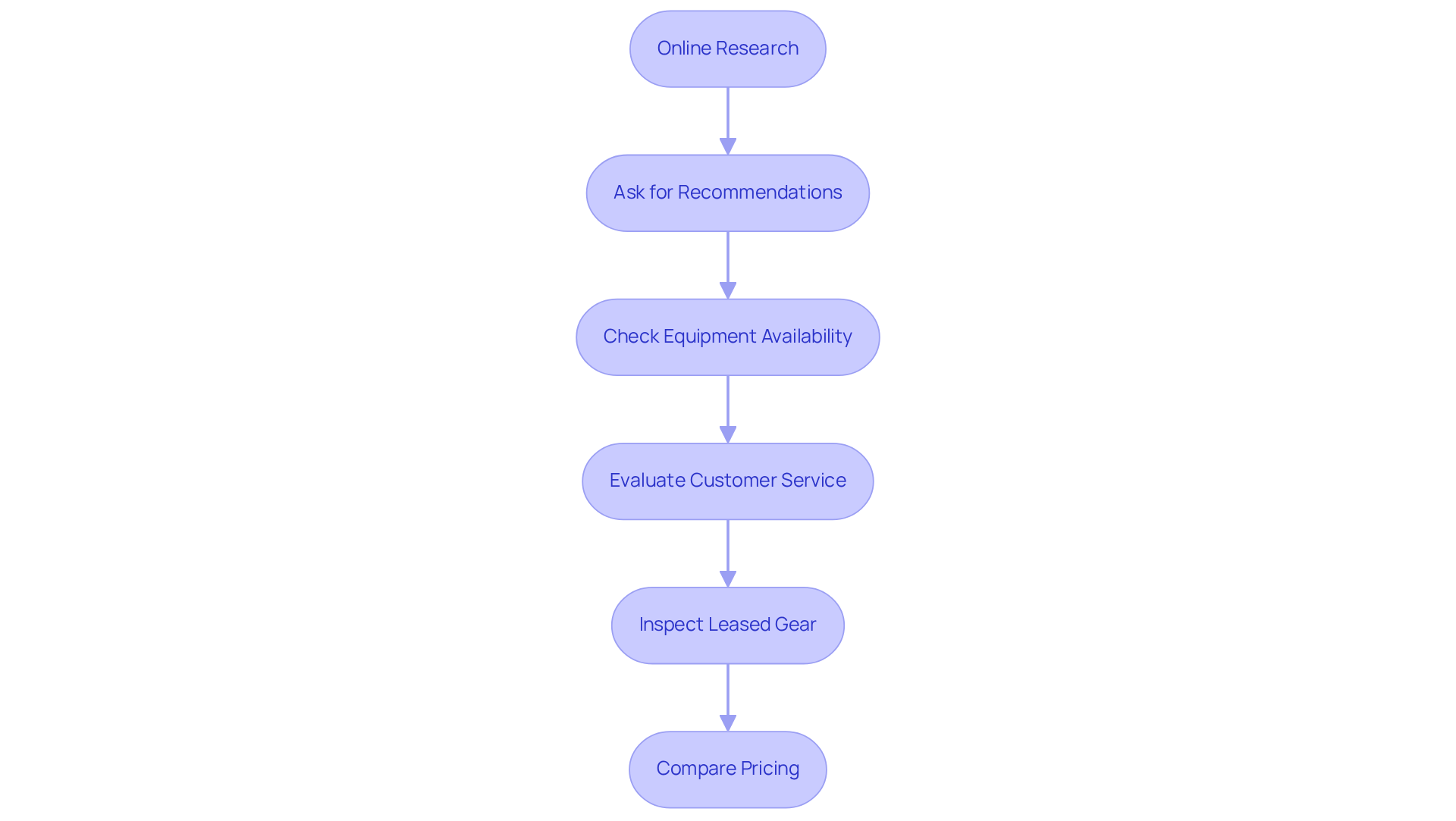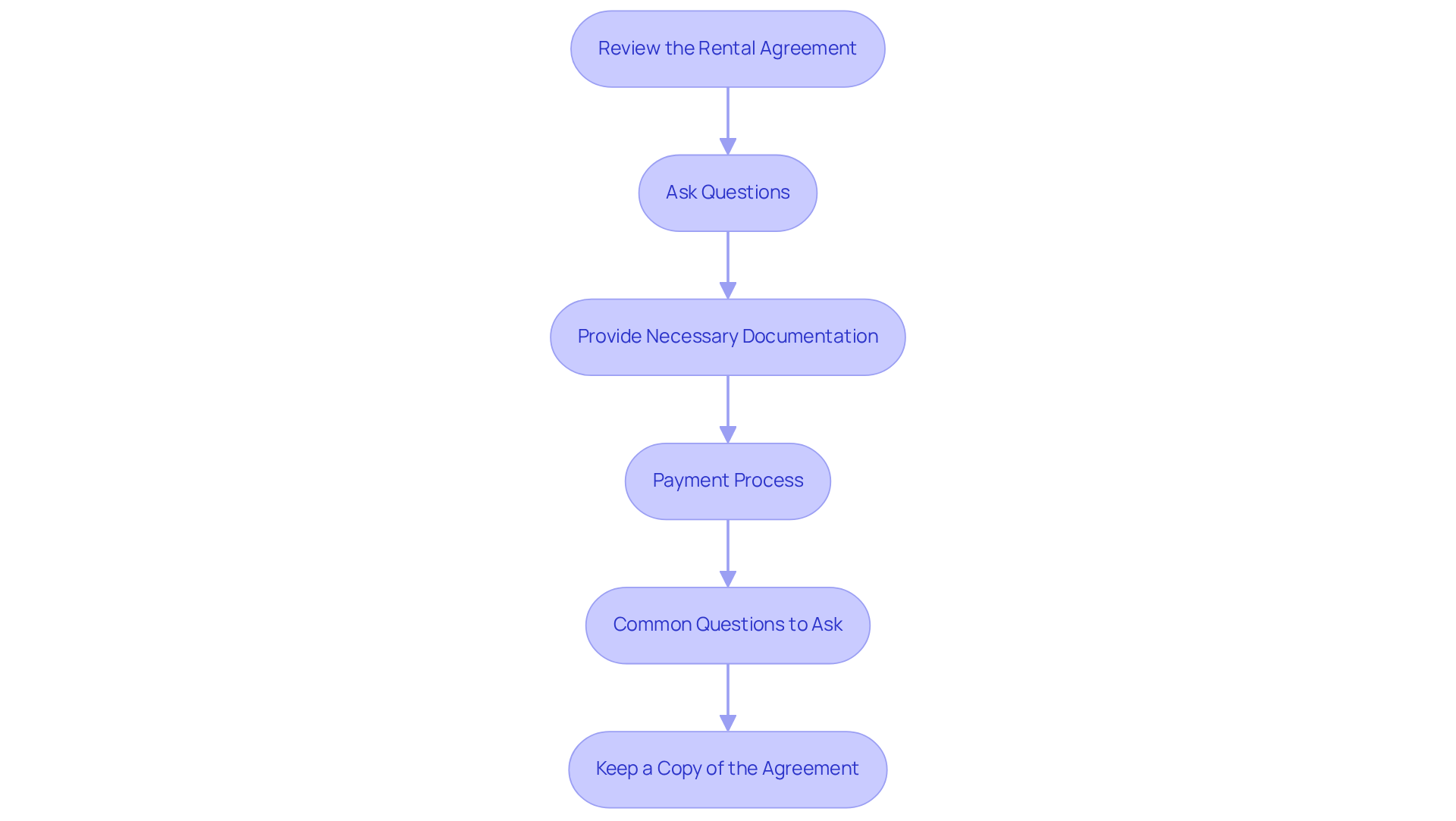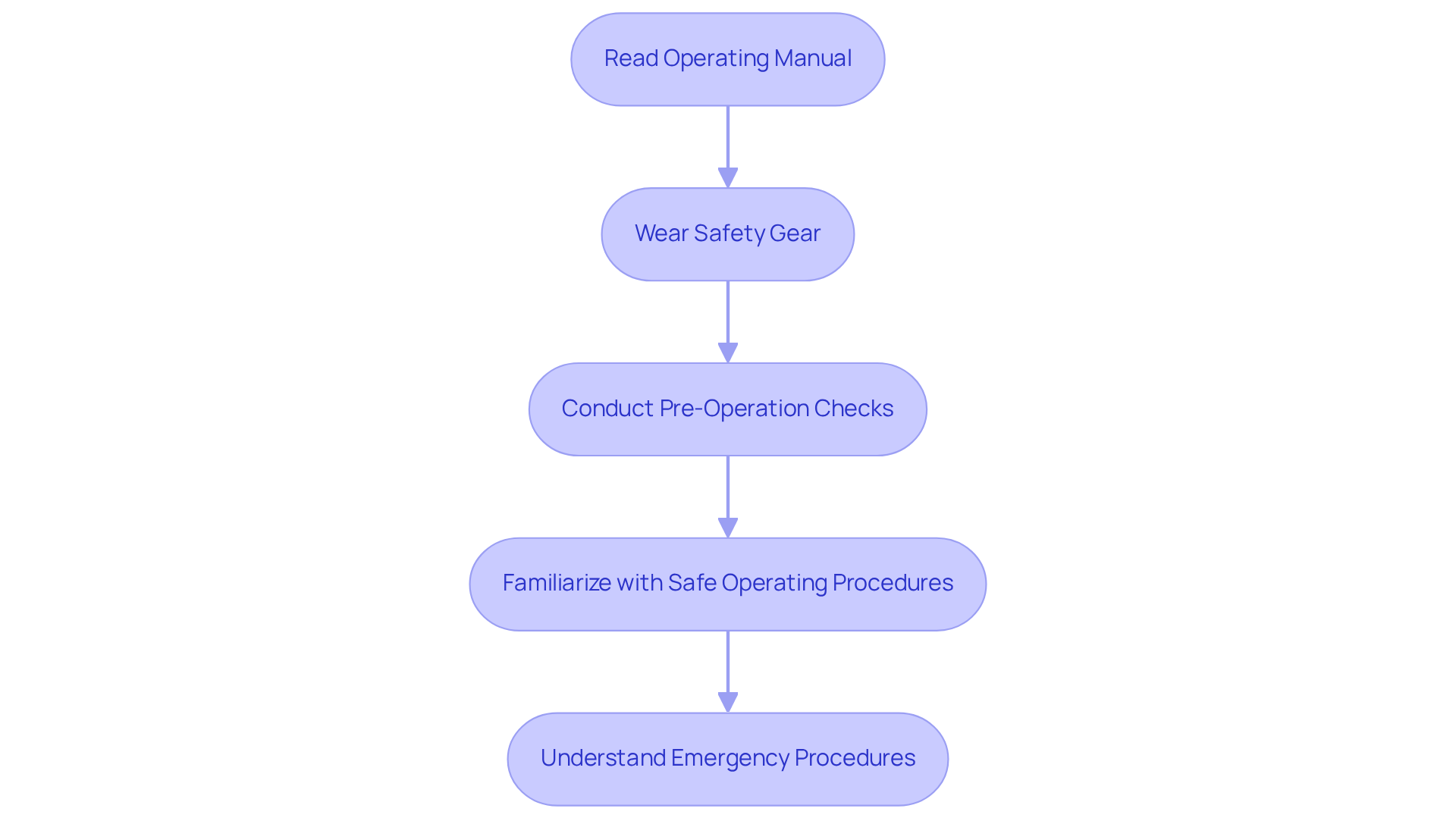Overview
This article delineates four essential steps to secure a mini excavator with hammer rental:
- Evaluate your project needs to ensure the right equipment selection.
- Research rental companies thoroughly, focusing on those with positive customer feedback.
- Complete the rental agreement with clarity, as it sets the foundation for your rental experience.
- Understand operating procedures and adhere to safety protocols to ensure a successful and efficient rental process.
Each step is fortified by detailed guidance on assessing project requirements, selecting reputable companies, ensuring clarity in rental terms, and prioritizing safety, all of which contribute to a seamless and effective rental experience.
Key Highlights:
- Evaluate project needs by assessing project type, site conditions, depth and reach requirements, and duration of use.
- The small excavator leasing market is expected to grow at a CAGR of 4.2% from 2023 to 2033, with average rental costs between $200 to $500 per day.
- Research reputable rental companies using online reviews, recommendations, and checking equipment availability.
- Assess customer service responsiveness and inspect leased equipment for condition before acceptance.
- Review the rental agreement carefully, clarify any uncertainties, and ensure necessary documentation is ready for the leasing process.
- Understand payment methods, inquire about maintenance policies, and keep a copy of the rental agreement for future reference.
- Read the operating manual, wear appropriate personal protective gear, and conduct pre-operation checks before using the equipment.
- Familiarise yourself with safe operating procedures and emergency protocols to minimise risks on the job site.
Introduction
Securing a mini excavator rental is a vital step in any construction project, yet the complexities of the process are often overlooked. Understanding the specific needs of a project—ranging from terrain analysis to equipment selection—can significantly influence both efficiency and costs.
With the rising demand for mini excavators and the potential for unforeseen expenses, navigating the rental landscape while ensuring safety and compliance becomes paramount.
This guide explores the essential steps to effectively secure a mini excavator with hammer rental, offering insights that can lead to a successful and hassle-free experience.
Identify Your Project Needs and Requirements
To effectively secure your mini excavator with hammer rental, begin by evaluating the scope of your project. Consider the following critical factors:
- Project Type: Identify whether your project involves digging, trenching, or demolition. Each task requires specific tools designed for its unique needs.
- Site Conditions: Analyze the terrain and available space. Is the area confined or expansive? This assessment will dictate the size and type of mini excavator that is suitable for your requirements.
- Depth and Reach: Establish the depth you need to excavate and the reach required for your tasks. This information is crucial for selecting the appropriate model that can handle your project effectively.
- Duration of Use: Estimate the length of time you will need the tools. Understanding your lease duration is vital, as it directly influences your leasing terms and total expenses.
By clearly defining these parameters, you can make informed decisions about the equipment necessary for your project, including a mini excavator with hammer rental, ensuring efficiency and cost-effectiveness in your operations.
Furthermore, consider that the small excavator leasing market is projected to expand at a compound annual growth rate (CAGR) of 4.2% from 2023 to 2033, indicating a rising demand for these leases. Average leasing prices for compact excavators generally range from $200 to $500 per day, based on the specific model and leasing duration. Understanding these financial implications, along with the costs associated with excavation tasks—such as soil testing ($700 to $2,200) and foundation installation ($4,000 to $14,750)—will further aid in your planning and budgeting.

Research and Select a Reputable Rental Company
To find a reputable rental company for your mini excavator and hammer, follow these essential steps:
-
Online Research: Begin by investigating companies that boast strong customer reviews and ratings. Platforms such as Google Reviews and Yelp serve as invaluable resources for understanding customer experiences. Notably, businesses achieving a 4.0 to 4.5-star rating can see an additional 28% in annual revenue, underscoring the significant impact of positive feedback. EZ Equipment Rental, located in Irving, TX, is recognized for its quality service and extensive range of equipment options, including small excavators, boom lifts, and more.
-
Ask for Recommendations: Seek advice from colleagues or industry professionals who can share their experiences with trustworthy leasing services. Personal recommendations often lead to reliable options that can streamline your decision-making process.
-
Check Equipment Availability: It is crucial to verify that the leasing service has the specific excavator and hammer required for your project. This step ensures you have the right tools to meet your project demands effectively. EZ Equipment Rental offers a diverse array of equipment, including mini excavators, boom lifts, forklifts, and other essential tools, catering to the DFW Metroplex.
-
Evaluate Customer Service: Contact the leasing company to assess their responsiveness and willingness to assist. A knowledgeable and supportive team can significantly enhance your leasing experience. Research indicates that 52% of consumers are likely to share negative experiences, making a proactive approach to customer service vital. EZ Equipment Rental takes pride in its accessible customer service throughout the Dallas-Fort Worth area.
-
Inspect Leased Gear: Before accepting the leased gear, ensure it is in good working condition. This critical step helps avoid disputes later and guarantees safety on the job site.
-
Compare Pricing: While cost should not be the sole factor, comparing rates among different providers is essential to secure a reasonable offer. Keep in mind that the average yearly income for sole proprietorship equipment leasing businesses in the U.S. is approximately $168,007, which can shape your expectations regarding pricing.
By conducting thorough research and evaluating these factors, you can confidently select a leasing service that aligns with your project requirements and expectations.

Complete the Rental Agreement and Payment Process
To successfully navigate the rental process for a mini excavator with hammer, adhere to these essential steps:
-
Review the Rental Agreement: Thoroughly examine the contract, focusing on rental duration, fees, and any potential additional charges for damages or late returns. Understanding these specifics is vital, as 84% of construction firms in the U.S. prefer leasing machinery to avoid unforeseen expenses. As Josh Nickell, Vice President of the American Rental Association's equipment segment, emphasizes, "Understanding the terms is crucial for a smooth transaction."
-
Ask Questions: Should any terms remain unclear, do not hesitate to seek clarification from the leasing company. A solid grasp of the leasing terms and conditions is crucial for ensuring a seamless transaction.
-
Provide Necessary Documentation: Be prepared to present identification, proof of insurance, and any other required documents. This step is essential to expedite the leasing process, which typically requires around two weeks for construction tools.
-
Payment Process: Confirm the accepted payment methods with the leasing firm. Understand the payment schedule—whether it necessitates upfront payment or allows for installments. This clarity aids in managing your budget effectively, especially since leasing construction machinery can save businesses 30-50% of total ownership expenses. Additionally, be aware that 39% of yearly income is allocated to material expenses for a machinery leasing business, underscoring the financial implications of any extra fees.
-
Common Questions to Ask: Before finalizing the agreement, consider inquiring with the leasing company about their policies on maintenance, insurance coverage, and procedures in the event of equipment failure. This ensures you are fully informed and prepared.
-
Keep a Copy of the Agreement: After signing, retain a copy of the lease agreement for your records. This document will prove invaluable in case of disputes or questions that may arise later.
By diligently following these steps, you can ensure a seamless leasing experience and mitigate potential issues, allowing you to focus on your construction project with confidence.

Understand Operating Procedures and Safety Guidelines
Before operating the mini excavator and hammer, understanding the following key procedures is crucial:
-
Operating Manual: Always read the operator's manual provided by the rental company. This document contains essential information regarding the device's features, functions, and safety protocols, which are vital for effective operation. Notably, a significant percentage of operators do not read the operating manual before use, leading to unsafe practices.
-
Safety Gear: Donning suitable personal protective gear (PPE) is essential. Ensure you have hard hats, gloves, safety glasses, and reflective vests for visibility to protect yourself from potential hazards on the job site.
-
Pre-Operation Checks: Conduct a thorough inspection of the apparatus before use. This includes checking fluid levels, brakes, and inspecting for any visible damages. Regular inspections can prevent accidents and ensure the machinery operates efficiently. As Tim Forestell mentions, "A great method to reduce the risk and injury is to arrange regular safety inspections of your tools, including mini excavators."
-
Safe Operating Procedures: Familiarize yourself with the controls and operation techniques. Understanding how to safely maneuver the mini excavator with hammer rental and effectively use the hammer attachment is critical to minimizing risks. Operators should also be aware that a significant percentage of them do not read the operating manual before use, which can lead to unsafe practices.
-
Emergency Procedures: Be ready for emergencies by understanding how to swiftly power down the machinery and what actions to take in different situations. This knowledge can be vital in preventing injuries and ensuring a swift response to incidents. If first aid cannot be administered on-site, it is crucial to call for help immediately.
By adhering to these guidelines, you can operate the equipment safely and efficiently, significantly reducing risks on the job site.

Conclusion
Securing a mini excavator with hammer rental is paramount for the success of construction projects. By meticulously assessing project needs and requirements, selecting a reputable rental company, completing the rental agreement and payment process, and understanding operating procedures and safety guidelines, operators can navigate the complexities of equipment rental confidently. Each step is vital in optimizing efficiency and minimizing costs while prioritizing safety on the job site.
Key insights from this guide highlight the importance of thorough research and preparation. A clear understanding of project specifications, including site conditions and equipment capabilities, enables informed decisions that align with budget constraints. Furthermore, choosing a reliable rental provider enhances the overall experience, ensuring access to well-maintained equipment and responsive customer service. By adhering to safety protocols and operational best practices, operators can effectively mitigate risks and maintain a secure working environment.
Ultimately, the process of securing a mini excavator rental should be approached with seriousness. By applying the steps outlined in this guide, individuals can significantly enhance their project outcomes while safeguarding their investments. Emphasizing proactive planning and informed decision-making is essential for successful construction endeavors, making it crucial to prioritize these considerations in every rental transaction.
Frequently Asked Questions
What should I consider when identifying my project needs for a mini excavator with hammer rental?
You should evaluate the project type (digging, trenching, or demolition), site conditions (terrain and space), depth and reach requirements, and the estimated duration of use.
How does the type of project affect the choice of mini excavator?
Different tasks require specific tools; for example, digging, trenching, and demolition each have unique needs that dictate the type of mini excavator suitable for the job.
Why is it important to analyze site conditions before renting a mini excavator?
Analyzing site conditions helps determine the size and type of mini excavator needed based on whether the area is confined or expansive.
What factors influence the depth and reach requirements for a mini excavator?
The depth you need to excavate and the reach required for your tasks are crucial for selecting an appropriate model that can handle your project effectively.
How does the duration of use affect leasing terms for a mini excavator?
Understanding the estimated length of time you will need the tools is vital, as it influences your leasing terms and total expenses.
What is the projected growth rate for the small excavator leasing market?
The small excavator leasing market is projected to expand at a compound annual growth rate (CAGR) of 4.2% from 2023 to 2033.
What are the average leasing prices for compact excavators?
Average leasing prices for compact excavators generally range from $200 to $500 per day, depending on the specific model and leasing duration.
What additional costs should I consider when planning for excavation tasks?
Additional costs include soil testing, which can range from $700 to $2,200, and foundation installation, which typically costs between $4,000 and $14,750.




